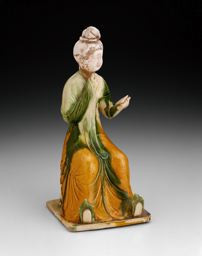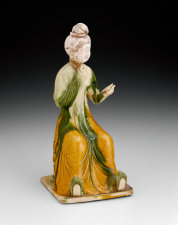Lesson Plan: Introducing Chinese Culture and Art

Name: Laura Rovelo-Meyran
School: Whittier Kindergarten Center
Subject Area: Art
Grade Level: Kindergarten
State Goals
- State Goal 26: Through creating and performing, understand how works of art are produced.
- State goal 27: Understand the role of the arts in civilizations, past and present.
Objectives
- Expose students to expressions of the Chinese culture through media such as silk, paper, origami, music, and porcelain.
- Promote multicultural education.
(Note: This unit was planned and realized with bilingual Kindergarten students with established and emergent reading skills. The whole unit, with 6 lessons, was completed in 2 weeks.)
Materials/Resources/Gallery Objects
- The Empress and the Silkworm by Lily Toy Hong
- Crayons
- Glue
- Craft sticks
- "Fuhng Yahng Flower Drum Song" from the CD, Children’s Songs Around the World, by Catherine Slonecki, Educational Activities, Inc.
- Crepe paper
- Paper plates
- Construction paper (multiple colors, including white)
- Tops
- Receptacle with water (to hold paper-making project)
- Blender
- Strainer
- Plastic bag
- Confetti, leaves, flowers
Procedures
Day 1
Introduction- Ask the students answer these questions:
- What is China?
- Where is China?
- What do you know about China?
- After finishing, the students watch a PowerPoint presentation about China and make connections about what they see with the questions above.
Day 2
Silkworm Story and Stick Puppet- The students view the cover of the book The Empress and the Silkworm by Lily Toy Hong and make guesses about what they think the book is about. During the reading, the teacher monitors comprehension, defining vocabulary and making connections as neeed.
- The students reenact the passage of the silkworm falling into the cup of tea, and how the empress discovered silk.
- The students will color, paste, and cut a stick puppet representing Si Ling-Chi, the empress that discovered silk.
Day 3
Chinese Dance (The students perform Chinese dance to Fuhng YahngFlower Drum Song from the Children’s Songs Around the World CD.)- The students line up by 6 in 4 rows and move their right arms in a circular motion, holding a ribbon.
- They turn to the right, change the ribbons to the left hands, and move their left arms in a circle.
- They turn to the right, change the ribbons to the right hand, and move their hands over their heads, in circles.
- They turn to the right, change the ribbons to their left hands and move their left hands over their heads in circles. They repeat this pattern until the music ends.
- The “ribbons” are made of crepe paper and wooden sticks.
Day 4
White and Blue Mosaics- The students observe images on the internet that show china (plates) in dichromatic tones and different patterns.
- The students create their own shape, using mosaic techniques.
Day 5
Tops with Designs- The students observe and compare Chinese and Mexican patterns to “copy” their favorites and draw them in a small white circle. This circle will have a small hole at the center.
- The students will place this circle in the handle of a top and make it turn, to see how it changes.
Day 6
Making paper- The students cut paper in small pieces and put it in a receptacle with water.
- The class waits one weekend to get the paper soft.
- In small amounts, put the mix of water and paper into a blender.
- With a strainer, try to eliminate as much water as possible. The resulting paste may be put over a plastic bag, and needs to be flattened as much as possible. At this time, confetti, different pieces of paper, leaves, or flowers may be added and them flattened again.
- Let it dry.
- When it is totally dry, remove it from the plastic.
- he students order the sequence of events in a worksheet.
Day 7
Origami- The students learn how to make different objects by folding paper. They get a pre-folded sheet of paper and in small groups (4 to 8), the teacher gives directions and supervises he students in following the right sequence.
- The students create a boat and an airplane. They may color and write names for these vehicles.
- The students can then race their boars and airplanes.

